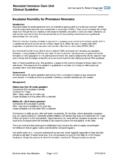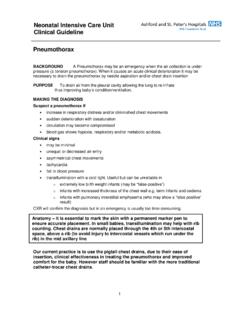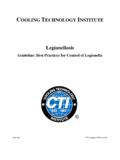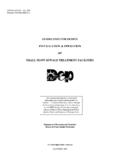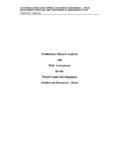Transcription of Sepsis Neonatal Guideline March 2015 - asph.mobi
1 Early Onset Sepsis in Neonates Page 1 of 9 26/03/2015 Early onset Sepsis in Neonates This Guideline aims to identify well babies who are at risk of Sepsis and unwell babies with Sepsis . It is important to differentiate between these two groups and remember that most neonates will fall into the former group. If Sepsis is subsequently ruled out, the well babies can ideally avoid unnecessary antibiotic courses and be discharged safely. Neonates who definitely need TESTS / TREATMENT for Sepsis AND observations# Any RED FLAG risk factors (see box, above) Signs of shock Seizures Neonates who definitely need OBSERVATIONS# but not (necessarily) tests/treatment All babies started on antibiotics Invasive GBS infection in previous baby + adequate IAP ( 2h before birth) Maternal GBS colonisation/UTI/infection in current pregnancy + adequate IAP ( 2h before birth) PROM >24hrs Prematurity (<37 weeks) (not including induced or non-labour / elective C/S)
2 Maternal intrapartum fever >38oC Required cardiac massage at birth Meconium stained liquor Jaundice <24hrs (not explained by Rh/ABO incompatibility) (See Jaundice Guideline ) Maternal antibiotic treatment does NOT mandate Neonatal antibiotic treatment, a close review of the risk factors and Neonatal clinical examination is needed. Neonatal Intensive Care Unit Clinical Guideline RED FLAG RISK FACTORS for Early Onset Sepsis (NICE guidance) Maternal infection 24hrs around labour Infection in other baby if multiple pregnancy Documented chorioamnionitis Maternal GBS colonisation/UTI/infection in current pregnancy with inadequate maternal intrapartum antibiotic prophylaxis (IAP) (<2hrs before delivery) Early Onset Sepsis in Neonates Page 2 of 9 26/03/2015 # At least 12 hrs of observations.
3 0hrs, 1hr, 2hrs and 2hrly for 12 hrs (on Neonatal observation chart including temperature, colour, capillary refill time, HR, RR) If there is maternal GBS then observations to continue until 24h of age (4hrly from 12-24 hrs) Abnormal observations review by doctor within 1 hour 1. Start antibiotic treatment if: a) Risk factor + clinical concern b) Persistent abnormal clinical indicators (2 consecutive readings) signs of respiratory distress >4hours of age hypoxia apnoea tachy/bradycardia temperature instability altered tone/behaviour/responsiveness 2. Grey areas discuss with senior colleague 2 risk factors persistent feed difficulty/intolerance (vomiting, distension, large aspirates) Anuria >24hrs of age persistent hypo/hyper-glycaemia metabolic acidosis (BE > -10) or lactate >2 3.
4 Maternal GBS colonisation first identified after birth but within 72hrs of life: Check if other risk factors Assess baby by hospital doctor if inpatient/midwife or GP if community If positive maternal colonisation identified after discharge but within 24h of birth readmit, assess and consider treatment. (For these cases please discuss with consultant) If abnormal observations/unwell baby readmit and treat If normal observations/well baby + identified GBS >24h after birth routine postnatal care and advice for parents Note that GBS colonisation only in a previous pregnancy is not deemed to be a significant risk factor, provided no other risk factors are Choices Tazocin for post natal ward / SCU babies Pen + Gent for babies admitted Neonatal Unit If in doubt, discuss with Neonatal registrar / consultant Early Onset Sepsis in Neonates Page 3 of 9 26/03/2015 STAGES OF MANAGEMENT OF BABY AT RISK OF EARLY ONSET Sepsis .
5 TIMELINE _____ _ _ _ _ _ _ _ _ _ _ _ _ _ _ _ _ _ _ _ _ _ _ _ _ _ _ _ _ _ _ _ _ _ _ _ _ _ _ _ _ _ _ _ _ _ _ _ _ _ _ _ _ _ _ _ _ _ _ _ _ _ _ _ _ _ _ _ _ _ _ _ _ _ __ 0hr 1hr 18hrs 36hr BABY RED FLAG RISK OF Sepsis or CLINICALLY SEPTIC Investigation (1) Blood cultures / CRP. (FBC, Clotting +/- LFT if unwell) Treatment (Choose and start within ONE hour) IV Tazocin (2) 8hrly for babies who are remaining on SCU or on the Postnatal Wards and are well Babies who are unwell should be admitted to the Neonatal Unit and commenced on IV Benzylpenicillin (3) and Gentamicin (4) At 36 hours If baby well and observations normal If both CRPs 10 mg/L If blood cultures negative after 24h incubation =>Stop antibiotics Decide if: o Gentamicin to be given 24 hourly or 36 hourly?
6 O Dose of Benzylpenicillin sufficient? o Further tests (LP, SPA, CXR, bloods needed)? Baby septic or CRP >10mg/L ADMIT to Neonatal Unit Baby well and initial CRP 10mg/L SECOND CRP and Clinical Review Repeat CRP after 18 hrs Second CRP >10mg/L and baby unwell Admit to Neonatal Unit, change to Pen + Gent The key question is: - is this baby at risk of Sepsis but not septic, or is the baby septic, regardless of risk? Repeat CRP after 18 hrs DECISION Can antibiotics be ceased? Clinical Review Second CRP 10mg/L Second CRP >10 mg/L Baby well admit to SCU if not already, continue Tazocin Second CRP >10mg/L Clinical review Early Onset Sepsis in Neonates Page 4 of 9 26/03/2015 Notes (1) Investigations: Lumbar Puncture Perform LP as part of initial investigation if: Strong clinical suspicion of septicaemia or severe generalised infection Clinical symptoms/signs of meningitis Consider LP on babies who are on antibiotics and did not have LP as part of initial investigation if.
7 CRP >20mg/L or rising quickly Positive blood culture Unsatisfactory response to antibiotic treatment including - persistent/re-emergent fever, deterioration in clinical condition, persistently abnormal inflammatory markers New clinical findings (especially neurological findings) Consider a repeat LP if baby is not making a good clinical recovery Do not perform LP if: Contraindicated: local infection over proposed LP site; unstable patient respiratory insufficiency; shock; on-going convulsions; coagulation abnormalities or thrombocytopenia (2) IV Tazocin is used as a single agent in this context. It is preferred to a cephalosporin due to the emergence of ESBL-producing gram negative organisms.
8 (3) IV Benzylpenicillin NICE CG149 suggests 25mg/kg BD. (However, clinical judgement may suggest an 8hrly regime or increased dosage) (4) Gentamicin See flow chart below to guide decision making on dose and interval MUST be prescribed correctly on Gentamicin chart only Some babies at risk of delayed clearance babies <32 weeks gestation, <1000g birth weight and for babies undergoing therapeutic hypothermia (cooling) and/or if there is suspicion/evidence of renal dysfunction should have lower dose (4mg/kg) less frequently (36 hourly) with pre-second dose levels checked. Rarely - consider measuring peak blood gentamicin concentrations in selected babies such as in those with: oedema macrosomia (birthweight more than kg) an unsatisfactory response to treatment proven Gram-negative infection.
9 Measuring peak concentrations 1 hour after starting the gentamicin infusion (D/W Consultant first) If a baby has a Gram-negative or staphylococcal infection, consider increasing the dose of gentamicin if the peak concentration is less than 8 mg/litre Discuss with parents at all stages and ensure parental understanding and provide WRITTEN information (parent information leaflet) Ensure the baby is managed in an appropriate care setting Once antibiotics stopped/at discharge: Give parents/carers advice re: when to seek medical attention VERBALLY and in WRITING (patient information leaflet) Give parents/carers a point of contact for advice Give parents/carers and GP a copy of the discharge summary Early Onset Sepsis in Neonates Page 5 of 9 26/03/2015 Gentamicin Prescribing Guidance This is based on NICE and NPSA guidance, as well as local audit findings and published data.
10 All second doses onwards should be prescribed on the Gentamicin prescribing Chart (Appendix 1). The times need to be according to the 24 hour clock. Clinical judgement is used to determine the safest prescription which should be double checked with the nursing staff. Nursing Staff Arrangements to be in place such as use of the red plastic apron to indicate that staff are preparing gentamicin and should not be disturbed Double signature checks are required for gentamicin checking and administration. The care bundle compliance chart must be completed (see Appendix 2) Gentamicin 4 mg/kg 36 hourly Check level 4 hours pre-second dose (36 hourly regimen) Level <2mg/L continue on 36 hourly regimen Gentamicin 5mg/kg 24 hourly Take level 4 hours pre-second dose Level <2mg/L continue Level >2mg/L omit and repeat level after 12 hours (or 24 hours if very high).

